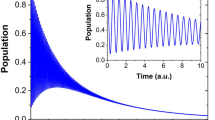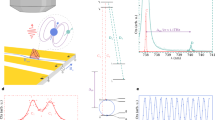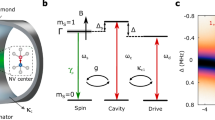Abstract
Quantum devices for sensing and computing applications require coherent quantum systems, which can be manipulated in fast and robust ways1. Such quantum control is typically achieved using external electromagnetic fields, which drive the system’s orbital2, charge3 or spin4,5 degrees of freedom. However, most existing approaches require complex and unwieldy gate structures, and with few exceptions6,7 are limited to the regime of weak coherent driving. Here, we present a novel approach to coherently drive a single electronic spin using internal strain fields8,9,10 in an integrated quantum device. Specifically, we employ time-varying strain in a diamond cantilever to induce long-lasting, coherent oscillations of an embedded nitrogen–vacancy (NV) centre spin. We perform direct spectroscopy of the phonon-dressed states emerging from this drive and observe hallmarks of the sought-after strong-driving regime6,11, where the spin rotation frequency exceeds the spin splitting. Furthermore, we employ our continuous strain driving to significantly enhance the NV’s spin coherence time12. Our room-temperature experiments thereby constitute an important step towards strain-driven, integrated quantum devices and open new perspectives to investigate unexplored regimes of strongly driven multilevel systems13 and exotic spin dynamics in hybrid spin-oscillator devices14.
This is a preview of subscription content, access via your institution
Access options
Subscribe to this journal
Receive 12 print issues and online access
$259.00 per year
only $21.58 per issue
Buy this article
- Purchase on SpringerLink
- Instant access to full article PDF
Prices may be subject to local taxes which are calculated during checkout




Similar content being viewed by others
References
Nielsen, M. A. & Chuang, I. L. Quantum Computation and Quantum Information (Cambridge Univ. Press, 2000).
Nadj-Perge, S., Frolov, S. M., Bakkers, E. P. A. M. & Kouwenhoven, L. P. Spin–orbit qubit in a semiconductor nanowire. Nature 468, 1084–1087 (2010).
Clarke, J. & Wilhelm, F. K. Superconducting quantum bits. Nature 453, 1031–1042 (2008).
Hanson, R., Kouwenhoven, L. P., Petta, J. R., Tarucha, S. & Vandersypen, L. M. K. Spins in few-electron quantum dots. Rev. Mod. Phys. 79, 1217–1265 (2007).
Dobrovitski, V., Fuchs, G., Falk, A., Santori, C. & Awschalom, D. Quantum control over single spins in diamond. Ann. Rev. Condens. Matter Phys. 4, 23–50 (2013).
Oliver, W. D. et al. Mach-Zehnder interferometry in a strongly driven superconducting qubit. Science 310, 1653–1657 (2005).
London, P., Balasubramanian, P., Naydenov, B., McGuinness, L. P. & Jelezko, F. Strong driving of a single spin using arbitrarily polarized fields. Phys. Rev. A 90, 012302 (2014).
MacQuarrie, E. R. et al. Coherent control of a nitrogen–vacancy center spin ensemble with a diamond mechanical resonator. Optica 2, 233–238 (2015).
Teissier, J., Barfuss, A., Appel, P., Neu, E. & Maletinsky, P. Strain coupling of a nitrogen–vacancy center spin to a diamond mechanical oscillator. Phys. Rev. Lett. 113, 020503 (2014).
Ovartchaiyapong, P., Lee, K. W., Myers, B. A. & Jayich, A. C. B. Dynamic strain-mediated coupling of a single diamond spin to a mechanical resonator. Nature Commun. 5, 4429 (2014).
Silveri, M., Tuorila, J., Kemppainen, M. & Thuneberg, E. Probe spectroscopy of quasienergy states. Phys. Rev. B 87, 134505 (2013).
Xu, X. et al. Coherence-protected quantum gate by continuous dynamical decoupling in diamond. Phys. Rev. Lett. 109, 070502 (2012).
Danon, J. & Rudner, M. S. Multilevel interference resonances in strongly driven three-level systems. Phys. Rev. Lett. 113, 247002 (2014).
Bennett, S. D. et al. Phonon-induced spin–spin interactions in diamond nanostructures: Application to spin squeezing. Phys. Rev. Lett. 110, 156402 (2013).
Gustafsson, M. V. et al. Propagating phonons coupled to an artificial atom. Science 346, 207–211 (2014).
Wilson-Rae, I., Zoller, P. & Imamoglu, A. Laser cooling of a nanomechanical resonator mode to its quantum ground state. Phys. Rev. Lett. 92, 075507 (2004).
MacQuarrie, E. R., Gosavi, T. A., Jungwirth, N. R., Bhave, S. A. & Fuchs, G. D. Mechanical spin control of nitrogen–vacancy centers in diamond. Phys. Rev. Lett. 111, 227602 (2013).
Gruber, A. et al. Scanning confocal optical microscopy and magnetic resonance on single defect centers. Science 276, 2012–2014 (1997).
Autler, S. H. & Townes, C. H. Stark effect in rapidly varying fields. Phys. Rev. 100, 703–722 (1955).
Cohen-Tannoudji, C., Dupont-Roc, J. & Grynberg, G. Atom–Photon Interactions: Basic Processes and Applications (Wiley, 1992).
Wrigge, G., Gerhardt, I., Hwang, J., Zumofen, G. & Sandoghdar, V. Efficient coupling of photons to a single molecule and the observation of its resonance fluorescence. Nature Phys. 4, 60–66 (2008).
Xu, X. et al. Coherent optical spectroscopy of a strongly driven quantum dot. Science 317, 929–932 (2007).
Baur, M. et al. Measurement of Autler–Townes and Mollow transitions in a strongly driven superconducting qubit. Phys. Rev. Lett. 102, 243602 (2009).
Fuchs, G. D., Dobrovitski, V. V., Toyli, D. M., Heremans, F. J. & Awschalom, D. D. Gigahertz dynamics of a strongly driven single quantum spin. Science 326, 1520–1522 (2009).
Dréau, A. et al. Avoiding power broadening in optically detected magnetic resonance of single NV defects for enhanced dc magnetic field sensitivity. Phys. Rev. B 84, 195204 (2011).
Timoney, N. et al. Quantum gates and memory using microwave-dressed states. Nature 476, 185–188 (2011).
Dolde, F. et al. Electric-field sensing using single diamond spins. Nature Phys. 7, 459–463 (2011).
Ithier, G. et al. Decoherence in a superconducting quantum bit circuit. Phys. Rev. B 72, 134519 (2005).
Buckle, S., Barnett, S., Knight, P., Lauder, M. & Pegg, D. Atomic interferometers. Opt. Acta 33, 1129–1140 (1986).
Jundt, G., Robledo, L., Högele, A., Fält, S. & Imamoğlu, A. Observation of dressed excitonic states in a single quantum dot. Phys. Rev. Lett. 100, 177401 (2008).
Kepesidis, K. V., Bennett, S. D., Portolan, S., Lukin, M. D. & Rabl, P. Phonon cooling and lasing with nitrogen-vacancy centers in diamond. Phys. Rev. B 88, 064105 (2013).
Maletinsky, P. et al. A robust scanning diamond sensor for nanoscale imaging with single nitrogen–vacancy centres. Nature Nanotech. 7, 320–324 (2012).
Acknowledgements
We thank V. Jacques for fruitful discussions, P. Appel for initial assistance with nanofabrication and L. Thiel for support with the experiment control software. We gratefully acknowledge financial support from SNI; NCCR QSIT; SNF grants 200021_143697; and EU FP7 grant 611143 (DIADEMS). A.N. holds a University Research Fellowship from the Royal Society and acknowledges support from the Winton Programme for the Physics of Sustainability.
Author information
Authors and Affiliations
Contributions
A.B. and J.T. carried out the experiment and analysed the data. E.N. provided essential support in sample fabrication. A.N. provided theoretical support and modelled the data. All authors commented on the manuscript. P.M. wrote the manuscript, conceived the experiment and supervised the project.
Corresponding author
Ethics declarations
Competing interests
The authors declare no competing financial interests.
Supplementary information
Supplementary Information
Supplementary Information (PDF 255 kb)
Rights and permissions
About this article
Cite this article
Barfuss, A., Teissier, J., Neu, E. et al. Strong mechanical driving of a single electron spin. Nature Phys 11, 820–824 (2015). https://doi.org/10.1038/nphys3411
Received:
Accepted:
Published:
Issue date:
DOI: https://doi.org/10.1038/nphys3411
This article is cited by
-
Reconfigurable quantum phononic circuits via piezo-acoustomechanical interactions
npj Quantum Information (2022)
-
Optomechanical interface between telecom photons and spin quantum memory
Nature Physics (2021)
-
Quantum guidelines for solid-state spin defects
Nature Reviews Materials (2021)
-
Electrical control of coherent spin rotation of a single-spin qubit
npj Quantum Information (2020)
-
Coherent acoustic control of a single silicon vacancy spin in diamond
Nature Communications (2020)



